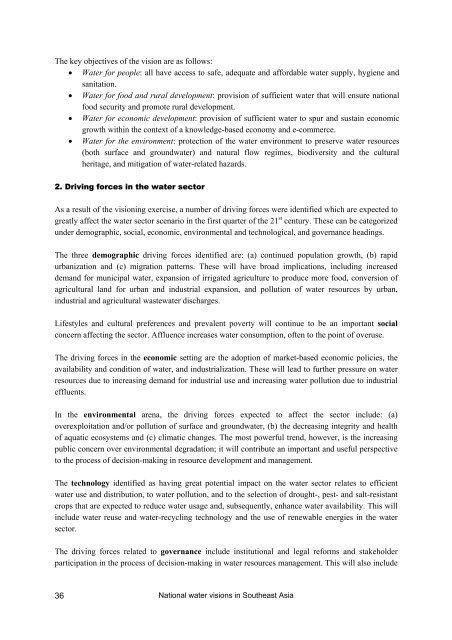The FAO-ESCAP pilot project on national water visions. From vision ...
The FAO-ESCAP pilot project on national water visions. From vision ...
The FAO-ESCAP pilot project on national water visions. From vision ...
Create successful ePaper yourself
Turn your PDF publications into a flip-book with our unique Google optimized e-Paper software.
<str<strong>on</strong>g>The</str<strong>on</strong>g> key objectives of the visi<strong>on</strong> are as follows:<br />
• Water for people: all have access to safe, adequate and affordable <strong>water</strong> supply, hygiene and<br />
sanitati<strong>on</strong>.<br />
• Water for food and rural development: provisi<strong>on</strong> of sufficient <strong>water</strong> that will ensure nati<strong>on</strong>al<br />
food security and promote rural development.<br />
• Water for ec<strong>on</strong>omic development: provisi<strong>on</strong> of sufficient <strong>water</strong> to spur and sustain ec<strong>on</strong>omic<br />
growth within the c<strong>on</strong>text of a knowledge-based ec<strong>on</strong>omy and e-commerce.<br />
• Water for the envir<strong>on</strong>ment: protecti<strong>on</strong> of the <strong>water</strong> envir<strong>on</strong>ment to preserve <strong>water</strong> resources<br />
(both surface and ground<strong>water</strong>) and natural flow regimes, biodiversity and the cultural<br />
heritage, and mitigati<strong>on</strong> of <strong>water</strong>-related hazards.<br />
2. Driving forces in the <strong>water</strong> sector<br />
As a result of the visi<strong>on</strong>ing exercise, a number of driving forces were identified which are expected to<br />
greatly affect the <strong>water</strong> sector scenario in the first quarter of the 21 st century. <str<strong>on</strong>g>The</str<strong>on</strong>g>se can be categorized<br />
under demographic, social, ec<strong>on</strong>omic, envir<strong>on</strong>mental and technological, and governance headings.<br />
<str<strong>on</strong>g>The</str<strong>on</strong>g> three demographic driving forces identified are: (a) c<strong>on</strong>tinued populati<strong>on</strong> growth, (b) rapid<br />
urbanizati<strong>on</strong> and (c) migrati<strong>on</strong> patterns. <str<strong>on</strong>g>The</str<strong>on</strong>g>se will have broad implicati<strong>on</strong>s, including increased<br />
demand for municipal <strong>water</strong>, expansi<strong>on</strong> of irrigated agriculture to produce more food, c<strong>on</strong>versi<strong>on</strong> of<br />
agricultural land for urban and industrial expansi<strong>on</strong>, and polluti<strong>on</strong> of <strong>water</strong> resources by urban,<br />
industrial and agricultural waste<strong>water</strong> discharges.<br />
Lifestyles and cultural preferences and prevalent poverty will c<strong>on</strong>tinue to be an important social<br />
c<strong>on</strong>cern affecting the sector. Affluence increases <strong>water</strong> c<strong>on</strong>sumpti<strong>on</strong>, often to the point of overuse.<br />
<str<strong>on</strong>g>The</str<strong>on</strong>g> driving forces in the ec<strong>on</strong>omic setting are the adopti<strong>on</strong> of market-based ec<strong>on</strong>omic policies, the<br />
availability and c<strong>on</strong>diti<strong>on</strong> of <strong>water</strong>, and industrializati<strong>on</strong>. <str<strong>on</strong>g>The</str<strong>on</strong>g>se will lead to further pressure <strong>on</strong> <strong>water</strong><br />
resources due to increasing demand for industrial use and increasing <strong>water</strong> polluti<strong>on</strong> due to industrial<br />
effluents.<br />
In the envir<strong>on</strong>mental arena, the driving forces expected to affect the sector include: (a)<br />
overexploitati<strong>on</strong> and/or polluti<strong>on</strong> of surface and ground<strong>water</strong>, (b) the decreasing integrity and health<br />
of aquatic ecosystems and (c) climatic changes. <str<strong>on</strong>g>The</str<strong>on</strong>g> most powerful trend, however, is the increasing<br />
public c<strong>on</strong>cern over envir<strong>on</strong>mental degradati<strong>on</strong>; it will c<strong>on</strong>tribute an important and useful perspective<br />
to the process of decisi<strong>on</strong>-making in resource development and management.<br />
<str<strong>on</strong>g>The</str<strong>on</strong>g> technology identified as having great potential impact <strong>on</strong> the <strong>water</strong> sector relates to efficient<br />
<strong>water</strong> use and distributi<strong>on</strong>, to <strong>water</strong> polluti<strong>on</strong>, and to the selecti<strong>on</strong> of drought-, pest- and salt-resistant<br />
crops that are expected to reduce <strong>water</strong> usage and, subsequently, enhance <strong>water</strong> availability. This will<br />
include <strong>water</strong> reuse and <strong>water</strong>-recycling technology and the use of renewable energies in the <strong>water</strong><br />
sector.<br />
<str<strong>on</strong>g>The</str<strong>on</strong>g> driving forces related to governance include instituti<strong>on</strong>al and legal reforms and stakeholder<br />
participati<strong>on</strong> in the process of decisi<strong>on</strong>-making in <strong>water</strong> resources management. This will also include<br />
36<br />
Nati<strong>on</strong>al <strong>water</strong> visi<strong>on</strong>s in Southeast Asia
















